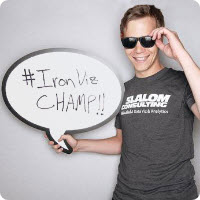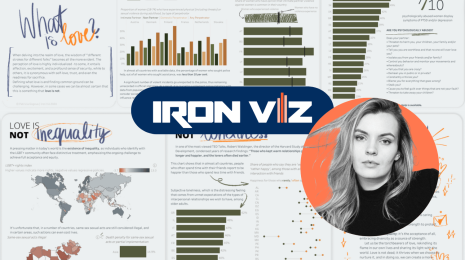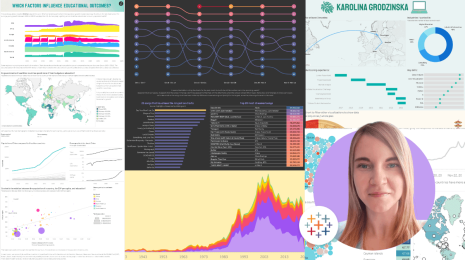An Interview with Previous Iron Viz Winners
With the first Iron Viz Feeder of 2017 in full swing, we interviewed the winners of the past three Iron Viz competitions to see where they get their inspiration from, when they know their viz is ready to submit, and what their personal-viz touches are.
If you don’t already know our past three winners, let me introduce Curtis Harris (winner 2016), Shine Pulikathara (winner 2015), and John Mathis (winner 2014).
1. Where do you find your Iron Viz inspiration?
Curtis: Generally speaking, half of my inspiration comes from the competition theme. Once Tableau provides the topic for the competition, I generally narrow down my sub-topic to areas that I have existing knowledge of or a topic of personal interest. The obvious route in the politics contest was on the U.S. election, but I knew I had a better opportunity to win if I chose a topic that interested me, rather than the obvious choice.
Shine: I find inspiration in a number of things, like discovering beautiful art in a museum, experiencing amazing seascapes along the coast or watching a creative food documentary. For Iron Viz, try to conceptualize something that would be truly unique and interesting. Think of all the possibilities, sleep over it and let the inspiration come to you!
John: My Iron Viz was based on Yelp data and my inspiration came from a time I read a review on a seafood restaurant in a town we were visiting that said “I can’t stand seafood and I can’t stand this restaurant”. It had me asking the questions of why would I trust someone’s review of a seafood establishment if the reviewer doesn’t even like seafood? Thus my questions was born of thinking about how to evaluate users for the accuracy of their reviews.
2. How much time (as a percent) do you spend in each step of making a viz? (ie, data prep, data exploration, building the viz, finishing-formatting touches)
Curtis: Data prep - 20%; Data exploration - 5%; Building the viz - 50%; Finishing touches - 25%
Shine: It really varies based on the project. For my Iron Viz feeder contest submission, I would say the mix was ~30% for data scraping and preparation, ~20% for data exploration, ~30% for building the viz and ~20% for the final touches. If you have good quality data, you can focus more of the time on building the viz. However, unique viz projects often come from putting in the effort to gather and prep your data.
John: Data exploration/prep 70% - vast majority was thinking about what questions I could potentially answer and seeing if the data available supported those analyses. Building the viz was probably 20% and the final bit of polish was 10%. For anyone fortunate enough to compete in the Iron Viz I’d strongly recommend they spend a lot of time invested in tackling an unique a creative problem. No amount of polish covering poor analysis will fool the judges!
3. What is a consistent challenge you face when building a viz and how do you overcome it?
Curtis: Putting it down! For Iron Viz I will generally spend about 25% of my total time on finishing touches, and when you are building a single viz across multiple weeks, I tend to "over-finish" my viz. One way I got over this hump in the mobile competition was to build one perfect worksheet, and then replicate it for all my other sheets. If you can be 100% satisfied with the layout and formatting of one sheet, bringing those details to your other sheets will save time.
Shine: Perhaps the most consistent challenge I face is judging when to take a glimmer of an idea and build it into a masterpiece of a visualization. Ideas come in all shapes and forms, and the obstacles to developing them may seem innumerable: the data is not good enough, the concept is too challenging to execute, the viz may not be as epic as the one that came before it, the viewpoint may be controversial, and so on. I can count so many times, when I had an idea and someone published it the next day before I even started on it. Do not wait! When inspiration strikes, start building.
John: Coming up with the idea or initial hypothesis! The way I overcome it is to really think about what decisions I personally make as it relates to the topic of the data and then think how I could improve my own decision making. If you can tailor the viz to answer questions that real people might ask, you’ll likely have a winner on your hands. If you think you have a great idea but struggle to really make it come to life, don’t be afraid to challenge yourself and come up with a different one.
4. When do you know your visualization is finished and ready to submit to the Iron Viz Feeder Challenge?
Curtis: My viz is finished probably five or six times throughout my build, and each time I find one or two little tweaks that need to be made. If my dashboard has 5 sheets on it, I will do a deep dive into each one of them to make sure they are formatted properly, beautiful, insightful, and easy to comprehend. Once I run this process and can't find anything to nitpick about, I know the viz is ready to submit. This may seem cumbersome, but I can't stress enough how much the little details matter in the Iron Viz feeder competitions!
Shine: To me, a viz is like a work of art, and there is always an additional brush stroke you may be tempted to add to bring it closer to perfection. In reality though, you reach a point where adding anything more would just distract from what is already there. There is an innate balance to every viz and I rely on my instinct to tell me when I have struck the right balance.
John: When you can show the final product to someone who knows nothing about Tableau or data visualization and they find it fascinating. I showed a few people my 4th down viz (feeder competition viz) and they were fascinated with it and spent 20 minutes playing with it. This told me I had a solid data product that would resonate strongly with the audience.
5. What is your secret ingredient / personal touch when it comes to vizzing?
Curtis: When it comes to Iron Viz, I want to be one of, if not the first to post my viz. People tend to remember the first or last item best... so sweat the small details, and get your pristine viz in front of the rest of the competition. The judges will remember that first, amazing viz, and it could help your chances when the competition goes to the judging phase.
Shine: For every viz I create, I care a lot about design, flow, accuracy, honesty and attention to detail. I try to pick topics I find interesting, so that I learn something new in return for the time I invest in building the viz.
John: Taking a broad trend or interesting insight and giving it a personal touch. When evaluating user’s overall trust worthiness, I found a woman (Diana) who scored very poorly. By constructing a custom URL in Tableau I was able to with a single click take a user from the dashboard straight to the review on Yelp. There the user can actually see Diana, the review they were just looking at, and make a very real, personal connection.
Want more tips on how to how to win an Iron Viz competition? Check out Shine’s 10 Steps to Winning the Tableau Iron Viz Championship, or Curtis's 10 more tips on winning the Iron Viz Championship. John also wrote about his Iron viz experience on his blog.
To learn more about Iron Viz: Geospatial, see the challenge page.
Related Stories
Subscribe to our blog
Get the latest Tableau updates in your inbox.




 Read more about the 2016 competition
Read more about the 2016 competition 





